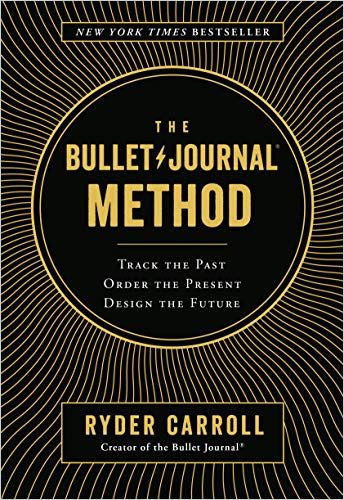Renowned product designer Ryder Carroll offers a practical and meditative approach to organizing your life via an ancient artform: Handwriting.

Write It Down
“BuJo”
Digital product designer Ryder Carroll suffers from attention deficit disorder. Frustrated by his disorganization, Carroll developed the “Bullet Journal” – or “BuJo” – method to keep track of all the moving parts in his life. His method can help you sort your goals, remember books you read or want to read, track your progress on achieving your resolutions, plan your vacation, and separate your crucial and mundane tasks.
In addition to explaining how his method works, Carroll – in this New York Times bestseller – includes reasons to turn the confusion in your head into orderly entries in your notebook. He offers his method to anyone ready to scrap productivity apps for the meditative peace of pen and paper.
Meaning can reveal itself in the most unremarkable, unpredictable and quiet of moments. If we’re not listening to the world around us, as well as the one within, we may miss it: the music in the mundane.Ryder Carroll
Concepcíon de Léon, writing in The New York Times, notes that the brain cannot recall or maintain more than a few thoughts at once. She admires that Carroll’s method has “more than three million related posts on Instagram alone and a dedicated following inspired to create blogs and innovations to the original system.” While being seduced by the beauty of Carroll’s method, de Léon admits to what might be a common – if seldom confessed – user problem: She “couldn’t keep up the momentum.”
Organized Notebook
BuJo is an organized notebook – an analog antidote to being overwhelmed. Your notebook, Carroll explains, gives you a quiet place to stop, reflect and focus with the goal of increasing your productivity. He offers his method as a tool to ground you in mindfulness about where you are now and how that relates to where you want to go. The author suggests starting with the daily habit of looking inward to discover what matters to you.
Bujo isn’t only for keeping lists. While smartphones erode your attention span, the Bullet Journal forces you to go offline and think. A notebook is as flexible as you need it to be, unlike a productivity app designed by someone else. Writing by hand helps your brain learn and remember far more effectively than any app ever could.
As soon as you put pen to paper, you establish a direct link to your mind and often your heart. This experience has yet to be properly replicated in the digital space.Ryder Carroll
The Bullet Journal system is modular. It combines a journal, a planner, to-do lists, a sketchbook and favorite quotes in one notebook. Embrace the modules you find useful and ditch the rest. Carroll breaks down his journal into the Daily Log– in which you capture your thoughts, responsibilities and experiences; the Monthly Log – a calendar on one page and your tasks on the facing page; the Future Log –tasks upcoming after the current month; and the Index – a list on the first few pages listing what the rest of your pages hold.
Seasons of Life
Carroll prioritizes starting a new journal at the beginning of each year. As you start your new journal, read through the index of your existing journal – if you have one – to see where you spent your time. Migrating tasks at the end of the month and the year to a new month and year makes you consider them anew. And if something isn’t worth the time it takes to rewrite, it’s not a priority.
The power of the Bullet Journal is that it becomes whatever you need it to be, no matter what season of life you’re in. Ryder Carroll
Gain insight by reflecting on what you’ve written. Look beyond what you are doing to understand why you do it. Reflection lets you recognize shifting priorities, new meanings and dead weight. This is the emotional – rather than functional – core of this system, and it aligns with Carroll’s endorsement of daily mindfulness. Consistently checking in to reflect for five minutes daily helps you break out of autopilot and deepen your understanding and self-knowledge.
Thousands of Thoughts
Each day, you have thousands of thoughts, which your mind constantly tries to prioritize. To avoid decision fatigue, reduce your daily decision-making load by writing down your choices. This helps you clarify your tasks and goals, declutter your mind and focus on what’s meaningful.
To make future improvements, analyze what isn’t working for you now. Balance self-criticism with gratitude. Examine irksome situations during your Daily Reflections. Analyze events and whatever has happened to you and formulate your response instead of merely reacting. Frame the tasks within your control. Make them less about outcome and more about process.
Take a hard look at your journal, because there you’ll see your story unfolding, written in your own hand.Ryder Carroll
Carroll asks you to consider whether a goal is still worth pursuing despite how long it will take to accomplish? If not, he says, scratch it off.
He also provides a basic budget structure: columns for activities, the amount to save monthly to pay for them, total costs, and a tracking column to check and adjust what you’ve set aside month to month. Use longer entries to sort your priorities and unearth new tasks.
Working with your Bullet Journal system, Carroll cautions, is an art form. He suggests using it for two or three months before customizing it to your best advantage. Then you can augment its format and value any way you like, but first become familiar with the system.
A Mindful System
Carroll acknowledges that the hardest part about writing lists is finding justification for the time it requires. Still, his method for slowing down and reverting to an analogue life-organization system may speak most loudly to two widely separated demographics: those who grew up with pen and paper as the default communication mode and those who have been digital since kindergarten. It may prove harder for those in the middle generations – who long since surrendered every task to digital modes – to adapt.
If you look forward to coming back to your journal and feel that it’s your ally, then you’re doing it right.Ryder Carroll
The beauty of Carroll’s system is that you don’t have to embrace every aspect of it to benefit. It functions well as a philosophy – slow down, fight digital dominance of your life, and be mindful of your choices and how you spend your day – as well as it does an organizational system. Carroll’s approach – as with any Zen master’s method – shows breathtaking simplicity. The time he spent perfecting it and his attention to detail means you can start utilizing his method well before you finish reading his remarkably practical, insightful and accessible guide.
Related works on organizing your life include Getting Things Done: The Art of Stress-Free Productivity by David Allen; Martha Stewart’s Organizing: The Manual for Bringing Order to Your Life, Home & Routine by Martha Stewart; and, for adults who, like Carroll, have ADHD, Order from Chaos: The Everyday Grind of Staying Organized with Adult ADHD by Jaclyn Paul.







